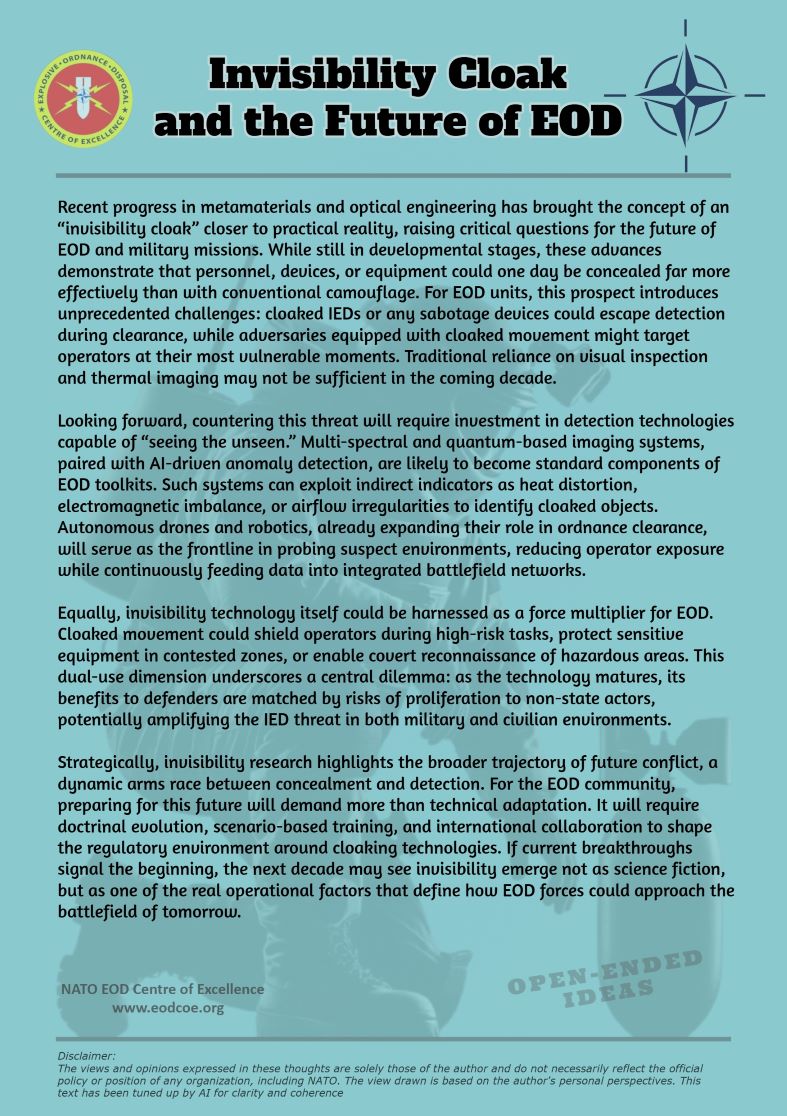
Invisibility Cloaks and the Future of EOD
Recent progress in metamaterials and optical engineering has brought the concept of an “invisibility cloak” closer to practical reality, raising critical questions for the future of EOD and military missions. While still in developmental stages, these advances demonstrate that personnel, devices, or equipment could one day be concealed far more effectively than with conventional camouflage. For EOD units, this prospect introduces unprecedented challenges: cloaked IEDs or any sabotage devices could escape detection during clearance, while adversaries equipped with cloaked movement might target operators at their most vulnerable moments. Traditional reliance on visual inspection and thermal imaging may not be sufficient in the coming decade.
Looking forward, countering this threat will require investment in detection technologies capable of “seeing the unseen.” Multi-spectral and quantum-based imaging systems, paired with AI-driven anomaly detection, are likely to become standard components of EOD toolkits. Such systems can exploit indirect indicators as heat distortion, electromagnetic imbalance, or airflow irregularities to identify cloaked objects. Autonomous drones and robotics, already expanding their role in ordnance clearance, will serve as the frontline in probing suspect environments, reducing operator exposure while continuously feeding data into integrated battlefield networks.
Equally, invisibility technology itself could be harnessed as a force multiplier for EOD. Cloaked movement could shield operators during high-risk tasks, protect sensitive equipment in contested zones, or enable covert reconnaissance of hazardous areas. This dual-use dimension underscores a central dilemma: as the technology matures, its benefits to defenders are matched by risks of proliferation to non-state actors, potentially amplifying the IED threat in both military and civilian environments.
Strategically, invisibility research highlights the broader trajectory of future conflict, a dynamic arms race between concealment and detection. For the EOD community, preparing for this future will demand more than technical adaptation. It will require doctrinal evolution, scenario-based training, and international collaboration to shape the regulatory environment around cloaking technologies. If current breakthroughs signal the beginning, the next decade may see invisibility emerge not as science fiction, but as one of the real operational factors that define how EOD forces could approach the battlefield of tomorrow.
Disclaimer:
The views and opinions expressed in these thoughts are solely those of the author and do not necessarily reflect the official policy or position of any organization, including NATO. The view drawn is based on the authors´ personal perspectives. This text has been enhanced using AI tools to improve clarity and coherence.